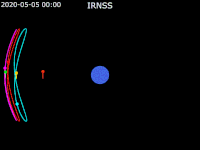
IRNSS-1C

| Mission type | Navigation |
|---|---|
| Operator | ISRO |
| COSPAR ID | 2014-061A |
| SATCAT no. | 40269 |
| Mission duration | 10 years[1] |
| Spacecraft properties | |
| Spacecraft | IRNSS-1D |
| Bus | I-1K |
| Manufacturer | ISRO Satellite Centre Space Applications Centre |
| Launch mass | 1,424.5 kilograms (3,140 lb)[1] |
| Dry mass | 598 kilograms (1,318 lb) |
| Power | 1,660 W[1] |
| Start of mission | |
| Launch date | 15 October 2014, 20:02 UTC |
| Rocket | PSLV-XL C26 |
| Launch site | Satish Dhawan FLP |
| Contractor | ISRO |
| Orbital parameters | |
| Reference system | Geocentric |
| Regime | Geostationary |
| Longitude | 83° East[1] |
| Perigee altitude | 35,697 kilometres (22,181 mi)[2] |
| Apogee altitude | 35,889 kilometres (22,300 mi)[2] |
| Inclination | 4.78 degrees[2] |
| Period | 1436.12 minutes[2] |
| Epoch | 23 January 2015, 21:16:09 UTC[2] |
IRNSS-1C is the third out of seven in the Indian Regional Navigation Satellite System (IRNSS) series of satellites after IRNSS-1A and IRNSS-1B. The IRNSS constellation of satellites is slated to be launched to provide navigational services to the region. It was launched on 15 October 2014 at 20:02 UTC by PSLV-C26 and will be placed in geostationary orbit.[1][3][4]

Satellite
The satellite will help augmenting the satellite based navigation system of India which is currently under development. The navigational system so developed will be a regional one targeted towards South Asia. The satellite will provide navigation, tracking and mapping services.[5]

IRNSS-1C satellite will have two payloads: a navigation payload and CDMA ranging payload in addition with a laser retro-reflector. The payload generates navigation signals at L5 and S-band. The design of the payload makes the IRNSS system inter-operable and compatible with Global Positioning System (GPS) and Galileo systems.[3] The satellite is powered by two solar arrays, which generate up to 1,660 watts, and has a life-time of ten years.

IRNSS-1C was launched successfully on 16 October 2014 at 1:32 am IST from Satish Dhawan Space Centre in Sriharikota.[6] An update from ISRO's official Facebook page on 18 October 2014 states that

Navigation Satellite IRNSS 1C Update:

The second orbit raising operation of IRNSS-1C is successfully completed by firing the Apogee Motor for 1,563 seconds. The current orbital parameters are:

See also
- Communication-Centric Intelligence Satellite (CCI-Sat)
- GPS-aided geo-augmented navigation (GAGAN)
- Satellite navigation
References
- ^ a b c d e "PSLV-C26/IRNSS-1C" (PDF). Archived from the original (PDF) on 21 October 2014. Retrieved 16 October 2014.
- ^ a b c d e "IRNSS 1C Satellite details 2014-061A NORAD 40269". N2YO. 23 January 2015. Retrieved 25 January 2015.
- ^ a b "IRNSS". space.skyrocket.de. Retrieved 6 December 2014.
- ^ Ravikiran, G. (16 October 2014). "India launches third navigation satellite". The Hindu. Retrieved 16 October 2014.
- ^ "ISRO: After GSLV launch, PSLV C24 with IRNSS-1B likely in March". India. 5 January 2014. Retrieved 6 January 2014.
- ^ Ravikiran, G. (16 October 2014). "India launches third navigation satellite". The Hindu.
External links
See what we do next...
OR
By submitting your email or phone number, you're giving mschf permission to send you email and/or recurring marketing texts. Data rates may apply. Text stop to cancel, help for help.
Success: You're subscribed now !







